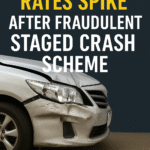
Auto insurance is an essential part of owning and operating a vehicle, providing financial protection against accidents, theft, and other unforeseen events. In Florida, certain cities pose higher risks for auto insurers due to factors like traffic congestion, accident rates, vehicle theft, and uninsured drivers. Understanding these risks is crucial for both drivers and insurance providers. In this blog, we’ll explore the high-risk cities in Florida and offer strategies for mitigating these risks. For personalized insurance advice, contact Samuel Bennett, Principal Agent at Island Insurance Group.
High-Risk Cities for Auto Insurance in Florida
Miami: A Hotspot for Traffic and Theft
- Traffic Congestion: Miami is infamous for its heavy traffic, leading to a higher likelihood of accidents.
- High Accident Rates: The city reports a significant number of traffic accidents and claims annually.
- Vehicle Theft: Miami has a relatively high rate of vehicle theft, increasing insurance risks for residents.
Orlando: The Impact of Tourism
- Tourism Traffic: The influx of tourists contributes to traffic congestion and a higher rate of accidents.
- Accident Rates: Orlando experiences a substantial number of traffic accidents each year.
- Uninsured Drivers: The city also has a higher rate of uninsured drivers, which adds to the overall risk.
Tampa: Managing Congestion and Claims
- Traffic Congestion: Heavy traffic and frequent congestion lead to more accidents.
- Accident Statistics: Tampa has notable rates of traffic accidents and insurance claims.
- Theft Rates: The city also faces a higher rate of vehicle theft compared to other areas.
Jacksonville: Urban Sprawl and Accident Risks
- Urban Sprawl: Jacksonville’s extensive road network contributes to increased driving and accident risks.
- Accident Rates: The city reports a relatively high rate of traffic accidents.
- Vehicle Theft: Higher vehicle theft rates further add to the insurance risk.
Fort Lauderdale: Dense Traffic and High Risks
- Traffic Density: Dense traffic and frequent congestion increase the likelihood of accidents.
- Accident Rates: Fort Lauderdale has a significant number of traffic accidents and related insurance claims.
- Uninsured Drivers: The prevalence of uninsured drivers adds to the risk for insured motorists.
St. Petersburg: Congestion and Theft Concerns
- Traffic and Congestion: Heavy traffic and urban congestion lead to higher accident rates.
- Insurance Claims: The city sees a substantial number of auto insurance claims.
- Theft Rates: Higher rates of vehicle theft increase the overall insurance risks.
Contributing Factors to High-Risk Auto Insurance
Accident Rates: Cities with higher frequencies of traffic accidents see more insurance claims, driving up costs for insurers.
Vehicle Theft: High rates of vehicle theft pose significant risks, leading to higher insurance premiums to cover potential losses.
Traffic Congestion: Congested traffic conditions increase the likelihood of collisions, contributing to higher accident rates.
Uninsured Drivers: Areas with higher rates of uninsured drivers present additional risks for insured motorists, often leading to more complex and costly claims.
Population Density: Higher population density typically correlates with increased traffic and accident rates, further complicating the insurance landscape.
Strategies for Mitigating High-Risk Auto Insurance
Defensive Driving Programs: Promoting defensive driving courses can help reduce accident rates. These programs educate drivers on safe driving practices and techniques to avoid collisions.
Anti-Theft Measures: Encouraging the use of anti-theft devices and measures can significantly reduce vehicle theft. Insurers may offer discounts for vehicles equipped with these safety features.
Insurance Discounts: Offering discounts for safe driving records and the installation of safety features incentivizes responsible driving and vehicle security.
Public Awareness Campaigns: Educating the public on safe driving practices through campaigns can help reduce accidents. These campaigns can highlight the importance of adhering to traffic laws and being vigilant on the road.
Enhanced Law Enforcement: Increasing traffic law enforcement can deter reckless driving and reduce the number of uninsured motorists on the road. Stricter enforcement of traffic laws helps maintain safer driving conditions.
Conclusion
Navigating the complexities of high-risk auto insurance in Florida requires an understanding of the unique challenges posed by different cities. Factors like traffic congestion, accident rates, vehicle theft, and uninsured drivers all contribute to the risk landscape. By adopting strategies to mitigate these risks, both drivers and insurers can work towards safer roads and more manageable insurance costs.
For residents of these high-risk cities, securing a robust auto insurance plan is crucial. It not only provides financial protection but also peace of mind. Contact Samuel Bennett at Island Insurance Group for expert advice and comprehensive coverage options tailored to your needs.
Contact Information:
Samuel Bennett
Principal Agent, Island Insurance Group
Phone: 866-820-7430 Ext 201
Email: sam@islandinsurancegroup.com
Website: islandinsurancegroup.com





